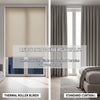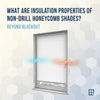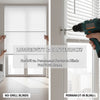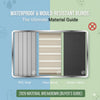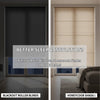Roller Blinds for Kitchens and Bathrooms: What You Need to Know
- by Mariam Labadze
Quick Answer
Kitchens and bathrooms require moisture-resistant roller blinds in PVC, vinyl, or specially treated polyester fabrics that repel water, resist mold growth, and wipe clean effortlessly. Essential considerations include choosing waterproof materials avoiding fabric that absorbs steam and cooking grease, selecting appropriate mounting positions away from direct splash zones whilst maintaining functionality, prioritizing easy-clean smooth surfaces over textured fabrics trapping dirt, opting for light colors hiding soap scum and water spots less visibly than dark shades, and ensuring proper ventilation preventing condensation buildup that even resistant materials eventually succumb to. PVC rollers cost £30-£60 per window, lasting 10-12 years in humid conditions versus fabric alternatives deteriorating within 2-3 years. Avoid standard fabric rollers, real wood, or any treatments with metal components prone to corrosion in moisture-heavy environments.
Why Standard Blinds Fail in Moisture-Heavy Rooms
Humidity Challenges – Bathrooms generate substantial steam during showers and baths, creating moisture-saturated air that penetrates porous materials. Standard fabric blinds absorb this moisture like sponges, creating perfect environments for mold and mildew growth that develops within weeks despite seemingly dry surfaces.
Kitchen humidity from cooking, dishwashing, and boiling water combines with airborne grease particles creating particularly challenging conditions. This combination proves even more problematic than bathroom moisture alone—the grease attracts and traps additional dirt whilst the oils gradually stain fabrics permanently regardless of cleaning efforts.
Temperature Fluctuations – Kitchens experience dramatic temperature changes from cooking heat to cooler periods, causing materials expanding and contracting. This thermal cycling stresses blinds, accelerating wear and causing warping in materials lacking dimensional stability that moisture-resistant options possess inherently.
Bathrooms similarly fluctuate between hot steamy conditions and cooler ambient temperatures, though less dramatically than kitchens. However, the humidity levels prove more extreme and sustained, creating different but equally challenging conditions for inappropriate materials.
Cleaning Requirements – These rooms demand frequent cleaning addressing cooking splashes, soap scum, and general grime accumulation. Standard fabric blinds prove nearly impossible cleaning adequately—surface wiping doesn't penetrate embedded dirt, whilst washing risks shrinkage, color bleeding, or fabric distortion that ruins appearances despite resolving cleanliness concerns.
PVC Roller Blinds: The Practical Solution
Complete Moisture Resistance – PVC (polyvinyl chloride) roller blinds offer ultimate practicality through complete water imperviousness. Steam condenses on surfaces and simply wipes away without absorption that causes fabric mold, warping, or deterioration. This fundamental advantage makes PVC the default recommendation for bathrooms and kitchens prioritizing longevity over aesthetics.
The non-porous plastic surface prevents moisture penetration entirely, eliminating mold growth possibilities that plague even supposedly moisture-resistant fabrics. This absolute resistance proves particularly valuable in poorly ventilated bathrooms where persistent humidity challenges all materials.
Easy Cleaning – Smooth PVC surfaces wipe clean effortlessly using damp cloths and mild detergent. Cooking grease, soap residue, and water spots remove completely without leaving stains or requiring aggressive cleaning products that might damage more delicate materials.
For thorough cleaning, PVC blinds can even be removed and rinsed under showers or with hoses, then dried thoroughly before reinstalling—maintenance impossibility with fabric alternatives regardless of claimed moisture resistance.
Cost Effectiveness – PVC rollers typically cost £30-£60 per standard window, making them economically attractive whilst delivering superior performance in challenging environments. The combination of low initial cost and 10-12 year expected lifespans creates excellent value compared to fabric alternatives requiring replacement every 2-3 years despite higher initial prices.
Aesthetic Evolution – Modern PVC extends beyond basic white utility appearances. Contemporary options include subtle textures, varied colors, and even wood-effect patterns providing visual interest whilst maintaining practical moisture resistance. This aesthetic variety allows coordinating with kitchen and bathroom décor without accepting purely functional appearances that dated PVC solely offered.
Moisture-Resistant Fabric Alternatives
Treated Polyester – Some polyester fabrics receive special moisture-resistant treatments creating temporary water repellency. These materials perform acceptably in moderately humid environments but eventually succumb to persistent bathroom steam or kitchen grease despite protective coatings that wear over time.
Consider treated fabrics for powder rooms, half baths, or kitchens with excellent ventilation where moisture exposure remains moderate. Full bathrooms with showers or poorly ventilated kitchens still warrant PVC for maximum longevity and minimum maintenance.
Performance Limitations – Even quality moisture-resistant fabrics don't match PVC's absolute imperviousness. The treatments reduce rather than eliminate moisture absorption, delaying but not preventing eventual mold development in sustained high-humidity conditions. This limitation means accepting shorter lifespans or increased maintenance compared to genuinely waterproof alternatives.
When Fabric Makes Sense – Guest bathrooms receiving occasional light use might accommodate moisture-resistant fabrics when aesthetic priorities outweigh pure practicality. The reduced exposure allows treated fabrics surviving longer whilst their superior appearance compared to PVC proves worthwhile for visible spaces where design impact matters.
Mounting Positions and Splash Zone Considerations
Distance from Water Sources – Position roller blinds avoiding direct water contact from showers, taps, or cooking splashes. Face-mounting slightly beyond shower enclosures rather than directly adjacent reduces exposure whilst maintaining privacy and light control functionality.
Kitchens benefit from blinds positioned away from hobs and sinks where cooking splashes and dishwashing spray create heaviest exposure. Windows above sinks require particularly careful material selection and mounting considerations preventing persistent wetting that even PVC eventually struggles withstanding without proper drainage and drying.
Recess vs. Face-Fix – Recess mounting within window frames creates neat integrated appearances but positions blinds closer to moisture sources and limits air circulation around treatments. Face-mounting beyond frames allows better airflow whilst creating physical distance from direct moisture exposure—often worthwhile trade-off despite less streamlined aesthetics.
Drainage Considerations – Ensure mounting positions allow water draining away from mechanisms and hardware rather than pooling where metal components risk corrosion. Slight forward tilt during installation encourages drainage, preventing water accumulation in tube mechanisms where moisture causes internal corrosion invisible until operational failures occur.
Color and Pattern Selection
Light Colors Hide Water Spots – White, cream, and pale colors conceal water spots and soap scum less visibly than dark shades where every mark shows prominently. This practical consideration proves particularly relevant for bathrooms where water spotting occurs regardless of wiping frequency.
Medium tones provide compromise—hiding marks better than dark colors whilst offering more visual interest than pure white. Grey, beige, or soft pastels create attractive appearances whilst maintaining practical spot-hiding benefits.
Pattern Camouflage – Subtle patterns or textures help disguising minor marks between thorough cleanings. This camouflage proves valuable in busy family bathrooms or kitchens where immediate spot cleaning doesn't always occur despite best intentions.
However, avoid busy patterns that feel overwhelming in typically compact bathrooms. The balance involves sufficient visual interest hiding marks without creating claustrophobic feelings through excessive pattern in limited spaces.
Maintenance Reality Check – Choose colors and patterns matching your realistic cleaning commitment. Pristine white requires frequent attention maintaining fresh appearances, whilst forgiving medium tones prove more practical for busy households where weekly rather than daily cleaning represents reality.
Ventilation Importance
Active Moisture Management – Even moisture-resistant blinds benefit from proper ventilation reducing overall humidity levels. Use bathroom extractor fans during and after showers, continuing operation 15-20 minutes post-shower removing residual moisture before it condenses on surfaces.
Kitchen range hoods vented externally remove cooking moisture and grease before dispersing throughout rooms. This active removal dramatically reduces conditions causing blind deterioration regardless of material resistance.
Natural Ventilation – Opening windows after bathroom use or during cooking whenever weather permits provides natural ventilation supplementing mechanical extraction. This simple practice significantly extends blind lifespans through reducing cumulative moisture exposure that even resistant materials eventually succumb to without adequate drying periods.
Preventing Condensation – Cold external walls meeting humid interior air creates condensation that drips down walls potentially wetting blinds. Addressing this through improved insulation or better heating reduces moisture problems affecting all bathroom and kitchen surfaces including window treatments.
Installation Considerations
Corrosion-Resistant Hardware – Use stainless steel or heavily plated fixings avoiding basic steel screws and brackets that rust rapidly in humid environments. Corroded fixings weaken, stain walls, and eventually fail, necessitating repairs that proper initial hardware selection prevents.
Plastic components resist corrosion entirely but must be sufficiently robust supporting blind weights without cracking or failing. Quality PVC blinds include appropriate corrosion-resistant hardware, but verify specifications before purchasing ensuring longevity that initial savings from cheap hardware ultimately negate.
Sealing Considerations – In particularly wet locations like directly above baths, consider applying clear silicone sealant around mounting brackets preventing water ingressing behind brackets where it causes wall damage and bracket corrosion despite surface materials resisting moisture adequately.
Professional vs. DIY – Moisture-prone installations warrant professional installation ensuring proper positioning, appropriate fixings, and correct techniques preventing water damage. The modest installation cost proves worthwhile avoiding expensive remediation from incorrect DIY approaches allowing moisture problems that proper installation prevents.
Maintenance Best Practices
Regular Wiping – Weekly damp-wiping removes accumulated moisture, soap residue, and cooking grease before buildup becomes difficult removing. This preventive maintenance takes minutes but significantly extends blind lifespans whilst maintaining fresh appearances.
Periodic Deep Cleaning – Monthly thorough cleaning with mild detergent solutions addresses accumulation that weekly maintenance misses. For PVC blinds, this might involve complete removal and rinsing, then thorough drying before reinstallation ensuring no moisture trapped in mechanisms.
Inspect for Mold – Regularly examine blinds for early mold signs—small dark spots typically appearing first along bottom edges where condensation accumulates. Address immediately with appropriate mold cleaning solutions preventing spread that becomes more difficult treating once established.
Mechanism Checks – Ensure operating mechanisms function smoothly without moisture-caused binding or corrosion. Lubricate as needed with appropriate products, and address any operational difficulties promptly before minor issues become major failures requiring complete replacement.
When to Replace
Visible Deterioration – Discoloration, warping, permanent staining, or mold that cleaning cannot remove signal replacement time. Continuing with obviously deteriorated blinds creates poor impressions in kitchens and bathrooms where cleanliness expectations run particularly high.
Operational Failures – Mechanisms that bind, fabrics that won't roll smoothly, or mounting hardware loosening despite tightening indicate wear exceeding repair value. Replacement proves more economical than repeated repair attempts on blinds approaching end-of-life.
Mold Recurrence – If mold returns repeatedly despite cleaning and proper ventilation, the blinds likely harbor spores deep within materials beyond surface cleaning reach. Replacement becomes necessary preventing ongoing mold exposure affecting indoor air quality and respiratory health.
At 1 Click Blinds, we specialize in moisture-resistant roller blinds perfect for UK kitchens and bathrooms. Our PVC options deliver the durability and easy maintenance these challenging environments demand, whilst our range ensures finding solutions that combine practicality with aesthetics suitable for these highly visible, frequently used spaces in your home.

